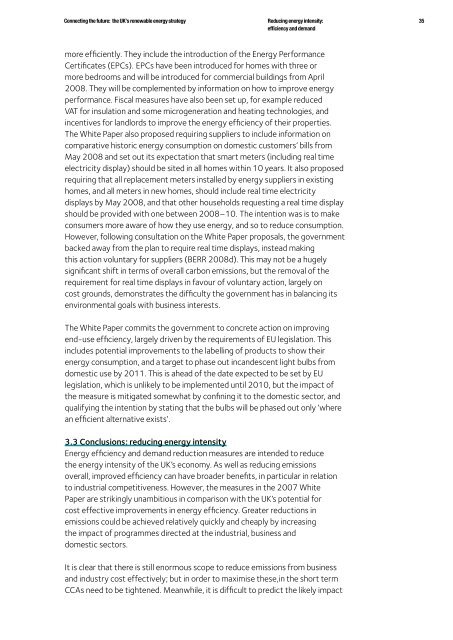Connecting the Future - Greenpeace UK
Connecting the Future - Greenpeace UK
Connecting the Future - Greenpeace UK
You also want an ePaper? Increase the reach of your titles
YUMPU automatically turns print PDFs into web optimized ePapers that Google loves.
<strong>Connecting</strong> <strong>the</strong> future: <strong>the</strong> <strong>UK</strong>’s renewable energy strategy<br />
Reducing energy intensity:<br />
efficiency and demand<br />
35<br />
more efficiently. They include <strong>the</strong> introduction of <strong>the</strong> Energy Performance<br />
Certificates (EPCs). EPCs have been introduced for homes with three or<br />
more bedrooms and will be introduced for commercial buildings from April<br />
2008. They will be complemented by information on how to improve energy<br />
performance. Fiscal measures have also been set up, for example reduced<br />
VAT for insulation and some microgeneration and heating technologies, and<br />
incentives for landlords to improve <strong>the</strong> energy efficiency of <strong>the</strong>ir properties.<br />
The White Paper also proposed requiring suppliers to include information on<br />
comparative historic energy consumption on domestic customers’ bills from<br />
May 2008 and set out its expectation that smart meters (including real time<br />
electricity display) should be sited in all homes within 10 years. It also proposed<br />
requiring that all replacement meters installed by energy suppliers in existing<br />
homes, and all meters in new homes, should include real time electricity<br />
displays by May 2008, and that o<strong>the</strong>r households requesting a real time display<br />
should be provided with one between 2008–10. The intention was is to make<br />
consumers more aware of how <strong>the</strong>y use energy, and so to reduce consumption.<br />
However, following consultation on <strong>the</strong> White Paper proposals, <strong>the</strong> government<br />
backed away from <strong>the</strong> plan to require real time displays, instead making<br />
this action voluntary for suppliers (BERR 2008d). This may not be a hugely<br />
significant shift in terms of overall carbon emissions, but <strong>the</strong> removal of <strong>the</strong><br />
requirement for real time displays in favour of voluntary action, largely on<br />
cost grounds, demonstrates <strong>the</strong> difficulty <strong>the</strong> government has in balancing its<br />
environmental goals with business interests.<br />
The White Paper commits <strong>the</strong> government to concrete action on improving<br />
end-use efficiency, largely driven by <strong>the</strong> requirements of EU legislation. This<br />
includes potential improvements to <strong>the</strong> labelling of products to show <strong>the</strong>ir<br />
energy consumption, and a target to phase out incandescent light bulbs from<br />
domestic use by 2011. This is ahead of <strong>the</strong> date expected to be set by EU<br />
legislation, which is unlikely to be implemented until 2010, but <strong>the</strong> impact of<br />
<strong>the</strong> measure is mitigated somewhat by confining it to <strong>the</strong> domestic sector, and<br />
qualifying <strong>the</strong> intention by stating that <strong>the</strong> bulbs will be phased out only ‘where<br />
an efficient alternative exists’.<br />
3.3 Conclusions: reducing energy intensity<br />
Energy efficiency and demand reduction measures are intended to reduce<br />
<strong>the</strong> energy intensity of <strong>the</strong> <strong>UK</strong>’s economy. As well as reducing emissions<br />
overall, improved efficiency can have broader benefits, in particular in relation<br />
to industrial competitiveness. However, <strong>the</strong> measures in <strong>the</strong> 2007 White<br />
Paper are strikingly unambitious in comparison with <strong>the</strong> <strong>UK</strong>’s potential for<br />
cost effective improvements in energy efficiency. Greater reductions in<br />
emissions could be achieved relatively quickly and cheaply by increasing<br />
<strong>the</strong> impact of programmes directed at <strong>the</strong> industrial, business and<br />
domestic sectors.<br />
It is clear that <strong>the</strong>re is still enormous scope to reduce emissions from business<br />
and industry cost effectively; but in order to maximise <strong>the</strong>se,in <strong>the</strong> short term<br />
CCAs need to be tightened. Meanwhile, it is difficult to predict <strong>the</strong> likely impact




![[2007] EWHC 311 - Greenpeace UK](https://img.yumpu.com/22079793/1/184x260/2007-ewhc-311-greenpeace-uk.jpg?quality=85)











